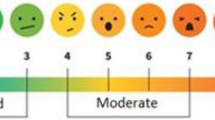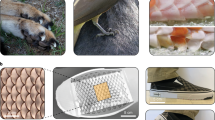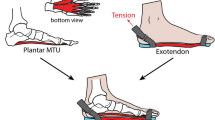Abstract
The two most popular ways to lace shoes have historically been to use 'criss-cross' or 'straight' lacing — but are these the most efficient? Here we demonstrate mathematically that the shortest lacing is neither of these, but instead is a rarely used and unexpected type of lacing known as 'bowtie' lacing. However, the traditional favourite lacings are still the strongest.
Similar content being viewed by others
Main
The 2n eyelets of an idealized shoe are the points of intersection of two vertical lines and n equally spaced horizontal lines in the plane. The two columns of eyelets are one unit apart, and two adjacent rows of eyelets are a distance h apart. An n-lacing of our shoe is a closed path in the plane that consists of 2n line segments, the end points of which are the 2n eyelets.
For any given eyelet, we require that at least one of the two segments that ends in it should not be contained in the same column as that eyelet; this condition ensures that every eyelet genuinely contributes towards pulling the two sides of the shoe together. Virtually all lacings that are actually used satisfy this condition.
We call a lacing 'dense' if neither of the two segments ending in any eyelet is contained in the same column as the eyelet — that is, a dense lacing zigzags back and forth between the two columns of eyelets as, for example, do the traditional lacings (Fig. 1a, b). Finally, we assume that n is at least 2.
a, b, The most popular n-lacings, the criss-cross n-lacing (a) and the two straight n-lacings (b) are also the strongest n-lacings (here n is the number of pairs of eyelets). c–e, The shortest n-lacings are the bow-tie n-lacings. They are made up of ends, gaps and crosses (c). If n is even, there is exactly one bow-tie n-lacing (d) consisting of the two ends at the top and bottom, n/2 gaps and n/2 − 1 crosses. If n is odd, there are exactly (n + 1)/2 different bow-tie n-lacings (e) consisting of the two ends, (n − 1)/2 gaps and (n − 1)/2 crosses.
Using standard combinatorial techniques, we find that the number of n-lacings is

where m = n/2 for even n, and m = (n − 1)/2 for odd n. The number of dense n-lacings is

The length of an n-lacing is the sum of the lengths of the segments that it consists of. Using the symmetries of the configuration of eyelets, it is possible to design a powerful list of local shortening rules and to use these to identify the bow-tie n-lacings as the shortest n-lacings (Fig. 1c–e). Furthermore, by generalizing earlier results1,2,3,4, we can show that the criss-cross n-lacing is the shortest dense n-lacing, even if the eyelets are not fully aligned. Note that it is also possible to identify the longest dense n-lacings for general n.
When you pull on the ends of a shoelace, it acts like a pulley. Ideally, the tension along the shoelace is a positive constant, T. This tension gives rise to a total tension, Thor, of the pulley in the horizontal direction; that is, the direction in which the two sides of the shoe are being pulled together. This total tension, Thor, is the sum of all horizontal components of T along the different segments of the lacing. The strongest n-lacings are then n-lacings that maximize Thor.
The unique dense 2-lacing is also the strongest 2-lacing. Note that the shortest n-lacing is independent of the distance h between two adjacent rows of eyelets. In contrast, for n > 2, the strongest n-lacing does depend on h. We can show that there is a positive value, hn, such that the strongest n-lacings are: the criss-cross n-lacing, for h < hn; the criss-cross n-lacing and the straight n-lacings, for h = hn; and the straight n-lacings, for h > hn.
For many real shoes with n pairs of eyelets, the ratio of the distance between adjacent rows of eyelets and the distance between the columns is very close to hn. This means that no matter whether you prefer to lace them straight or criss-crossed, you come close to maximizing the total horizontal tension when you pull on the two ends of one of your shoelaces.
And what is the strongest way to tie your shoelaces?5 Most people place one half-granny knot on top of another (it is not essential to consider the loops here), which results in either a notoriously unstable granny knot or a very stable reef knot, depending on whether the two half-knots have the same or opposite orientation. As we have seen, hundreds of years of trial and error have led to the strongest way of lacing our shoes, but unfortunately the same cannot be said about the way in which most of us tie our shoelaces — with a granny knot.
References
Halton, J. H. Math. Intell. 17, 37–41 (1995).
Misiurewicz, M. Math. Intell. 18, 32–34 (1996).
Stewart, I. Sci. Am. 78–80 (July 1996).
Stewart, I. Sci. Am. 86 (December 1996).
Smith, G. A. http://www.u.arizona.edu/~gasmith/knots/knots.html
Author information
Authors and Affiliations
Corresponding author
Ethics declarations
Competing interests
The author declares no competing financial interests.
Rights and permissions
About this article
Cite this article
Polster, B. What is the best way to lace your shoes?. Nature 420, 476 (2002). https://doi.org/10.1038/420476a
Issue Date:
DOI: https://doi.org/10.1038/420476a
This article is cited by
-
Laces high
Nature (2002)
Comments
By submitting a comment you agree to abide by our Terms and Community Guidelines. If you find something abusive or that does not comply with our terms or guidelines please flag it as inappropriate.




